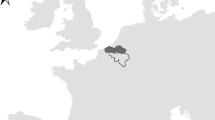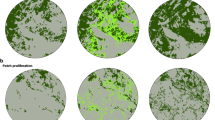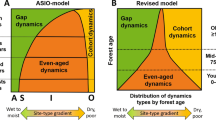Abstract
Naturally dynamic forests have a high proportion of biotopes with old large trees, diverse vertical and horizontal structure at multiple scales, and much dead wood. As such, they provide habitat to species and ecosystem processes that forests managed for wood production cannot provide to the same degree. Whether termed old-growth, ancient, virgin, intact, primeval or continuity forests, a major challenge and need is to map such potential high conservation value forest for subsequent inclusion in functional habitat networks for biodiversity conservation in forest landscapes. Given that the delivery time of natural forest properties is much longer than of industry wood, we explore the usefulness of using historical maps to identify forests that have been continuously present for 220 years (potential old-growth) versus 140 years (potential aging forest) in a case study in the Romanian Carpathian Mountains (see Online Resource 1). While the total forest cover increased by 35 % over the past two centuries, the area of potential aging and potential old-growth forest declined by 56 and 34 %, respectively. Spatial modelling of edge effects and patch size for virtual species with different requirements indicated an even greater decrease in the area of functional habitat networks of old-growth and ageing forest. Our analyses show that compared to simple mapping of potential high conservation forests, the area of functional habitat patches is severely overestimated, and caution is needed when estimating the area of potential high conservation value forests that form functional habitat networks, i.e. a green infrastructure. In addition, the landscape and regional scale connectivity of patches needs to be considered. We argue that the use of historical maps combined with assessment of spatial patterns is an effective tool for identifying and analyzing potential high conservation value forests in a landscape context.






Similar content being viewed by others
References
Aksenov D, Dobrynin D, Dubinin M et al (2002) Atlas of Russia’s intact forest landscapes. Global Forest Watch, Moscow
Angelstam P, Dönz-Breuss M (2004) Measuring forest biodiversity at the stand scale-an evaluation of indicators in European forest history gradients. Ecol Bull 51:305–332
Angelstam P, Roberge JM, Lõhmus A et al (2004) Habitat modelling as a tool for landscape-scale conservation—a review of parameters for focal forest birds. Ecol Bull 51:427–453
Angelstam P, Axelsson R, Elbakidze M, Laestadius L, Lazdinis M, Nordberg M, Pătru-Stupariu I, Smith M (2011a) Knowledge production and learning for sustainable forest management: European regions as a time machine. Forestry 84(5):581–596
Angelstam P, Andersson K, Axelsson R, Elbakidze M, Jonsson BG, Roberge JM (2011b) Protecting forest areas for biodiversity in Sweden 1991–2010: policy implementation process and outcomes on the ground. Silva Fennica 45(5):1111–1133
Angelstam P, Roberge JM, Axelsson R, Elbakidze M, Bergman KO, Dahlberg A, Degerman E, Eggers S, Esseen PA, Hjältén J, Johansson T, Müller J, Paltto H, Snäll T, Soloviy I, Törnblom J (2013) Evidence-based knowledge versus negotiated indicators for assessment of ecological sustainability: the Swedish Forest Stewardship Council standard as a case study. Ambio 42(2):229–240
Aune K, Jonsson BJ, Moen J (2005) Isolation and edge effects among woodland key habitats in Sweden: is forest policy promoting fragmentation? Biol Conserv 124:89–95
BirdLife European Forest Task Force (2009) Bulgarian-Romanian forest mapping project, final report
Biriş IA, Veen P (2005) Virgin forests in Romania. Inventory and strategy for sustainable management and protection of virgin forests in Romania. ICAS and KNNV, Bucharest. http://www.veenecology.nl/data/VirginforestRomaniaSummary.PDF. Accessed 14 Jun 2012
Biriş IA, Radu S, Doniţa N (2000) Criteria for identification, selection and assessment of virgin forests. Document ICAS, Bucharest
Borlea GhF (1999) Forest reserves and their research in Romania. In: Diaci J (ed) Virgin forests and forest reserves in central and east European countries. Department of Forestry and Renewable Forest Resources-Biotechnical Faculty, Ljubljana, pp 67–86
Brătescu P, Moruzzi I (1897) Dicţionar Geografic al Judeţului Prahova (geographical dictionary of Prahova County). Tipografia şi Legătoria Viitorul, Târgovişte [in Romanian]
Burrascano S (2010) On the terms used to refer to ‘natural’ forests: a response to Veen et al. Biodivers Conserv 19(11):3301–3305
Chen JQ, Franklin JF, Spies TA (1995) Growing-season microclimatic gradients from clear-cut edges into old-growth Douglas-fir forests. Ecol Appl 5:74–86
Coppin P, Jonckheere I, Nackaerts K, Muys B, Lambin E (2004) Digital change detection methods in ecosystem monitoring: a review. Int J Remote Sens 25:1565–1596
Darby HC (1956) The clearing of woodlands in Europe. In: Thomas WL (ed) Man′s role in changing the face of the Earth. University of Chicago Press, Chicago, pp 183–216
D’eon RG, Glenn SM (2005) The influence of forest harvesting on landscape spatial patterns and old-growth-forest fragmentation in southeast British Columbia. Landsc Ecol 20:19–33
Edman T, Angelstam P, Mikusinski G, Roberge JM, Sikora A (2011) Spatial planning for biodiversity conservation: assessment of forest landscapes’ conservation value using umbrella species requirements in Poland. Landsc Urban Plan 102:16–23
EEA (2010) European Environmental Agency. 10 messages for 2010—Forest ecosystems. http://www.eea.europa.eu/publications/10-messages-for-2010-2014-3/. Accessed 01 Mar 2012
Elbakidze M, Angelstam P, Andersson K, Nordberg M, Pautov Y (2011) How does forest certification contribute to boreal biodiversity conservation? Standards and outcomes in Sweden and NW Russia? For Ecol Manag 262(11):1983–1995
Esseen PA (1994) Tree mortality patterns after experimental fragmentation of an old-growth conifer forest. Biol Conserv 68:19–28
Estreguil Ch, Mouton C (2009) Measuring and reporting on forest landscape pattern, fragmentation and connectivity in Europe: methods and indicators–JRC Scientific and Technical Reports. Office for Official Publications of the European Communities, Luxembourg
Forests Europe (2011) Oslo Ministerial decision: European forests 2020. http://www.foresteurope2011.org/. Accessed 29 Jan 2012
Franklin JF, Forman RTT (1987) Creating landscape patterns by forest cutting: ecological consequences and principles. Landsc Ecol 1(1):5–18
Fritz Ö, Gustafsson L, Larsson K (2008) Does forest continuity matter in conservation?—A study of epiphytic lichens and bryophytes in beech forests of southern Sweden. Biol Conserv 141:655–668
FSC (2000) Report of the principle 9 advisory panel draft recommendation
FSC (2012) FSC principles and criteria for forest stewardship. https://ic.fsc.org/. Accessed 12 Feb 2013
Giurescu CC (1980) A history of the Romanian forest. Editura Academiei R.S.R, Bucharest
Giurgiu V, Doniţa N, Bândiu C, Radu S, Cenuşa R, Stoiculescu C, Biriş IA (2001) Les forêts vierges en Roumanie. Asbl, Forêt wallone, Louvain-la-Neuve
Grigore VR, Bucur C, Turtică M (2012) Ghid practic pentru identificarea şi managementul Pădurilor cu Valoare Ridicată de Conservare (toolkit for the identification and management of high conservation value forests) [in Romanian] http://www.certificareforestiera.ro/ Accessed 13 Feb 2013
Groom MJ, Gary KM, Carl RC (2006) Principles of conservation biology, 3rd edn. Sinauer Associates, Sunderland
Haines-Young R, Chopping M (1996) Quantifying landscape structure: a review of landscape indices and their application to forested landscapes. Prog Phys Geogr 20:418–445
Huzui AE, Abdelkader A, Pătru-Stupariu I (2011) Analysing urban dynamics using multi temporal satellite images in the case of a mountain area, Sinaia (Romania). Int J Digit Earth. doi:10.1080/17538947.2011.642901
Iojă CI, Pătroescu M, Rozylowicz L, Popescu V, Vergheleţ M, Zotta MI, Felciuc M (2010) The efficacy of Romania’s protected areas network in conserving biodiversity. Biol Conserv 143:2468–2476
Ioras F, Abrudan IV, Dautbasic M, Avdibegovic M, Gurean D, Ratnasingam J (2009) Conservation gains through HCVF assessments in Bosnia-Herzegovina and Romania. Biodivers Conserv 18:3395–3406
Jennings S, Nussbaum R, Judd N, Evans T (2003) The high conservation value forest toolkit. ProForest, Oxford
Jonsson MT, Fraver S, Jonsson BG (2009) Forest history and the development of old-growth characteristics in fragmented boreal forests. J Veg Sci 20:91–106
Kienast F (1993) Analysis of historic landscape patterns with a Geographical Information System—a methodological outline. Landsc Ecol 8:103–118
Kindlmann P, Burel F (2008) Connectivity measures: a review. Landsc Ecol 23:879–890
Knorn J, Kuemmerle T, Radeloff VC et al (2012a) Forest restitution and protected area effectiveness in post-socialist Romania. Biol Conserv 146:204–212
Knorn J, Kuemmerle T, Radeloff VC et al (2012b) Continued loss of temperate old-growth forests in the Romanian Carpathians despite an increasing protected area network. Environ Conserv. doi:10.1017/S0376892912000355
Kozak J (2003) Forest cover change in the Western Carpathians in the past 180 years. A case study in the Orawa Region in Poland. Mt Res Dev 23:369–375
Kozak J, Estreguil C, Vogt P (2007) Forest cover and pattern changes in the Carpathians over the last decades. Eur J Forest Res 126:77–90
Kumar P (ed) (2010) The economics of ecosystems and biodiversity (TEEB). Ecological and Economic Foundations, Earthscan, London
Kurlavicius P, Kuuba R, Lukins M, Mozgeris G, Tolvanen P, Karjalainen H, Angelstam P, Walsh M (2004) Identifying high conservation value forests in the Baltic States from forest databases. Ecol Bull 51:351–366
Larsson TB, Angelstam P, Balent G et al (2001) Biodiversity evaluation tools for European forests. Ecol Bull 50:236
Lundquist JE, Lindner LR, Popp J (2001) Using landscape metrics to measure suitability of a forested watershed: a case study for old growth. Can J For Res 31:1786–1792
Mack F (1906) Fragmente din istoricul melezului si pinului in Romania (chapters of the pine tree’s history), translation. Z Forst-Jagdwes-Rev Pădurilor XX:304–311 [in Romanian]
Marsik M, Stevens F, Southworth J (2011) Rates and patterns of land cover change and fragmentation in Pando, northern Bolivia, 1986 to 2005. Prog Phys Geogr. doi:10.1177/0309133311399492
McGarigal K, Cushman SA, Neel MC, Ene E (2002) FRAGSTATS: spatial pattern analysis program for categorical maps. Computer software program produced by the authors at the University of Massachusetts, Amherst. http://www.umass.edu/landeco/research/fragstats/fragstats.html. Accessed 16 Dec 2011
MCPFE (2002) Ministerial conference on the protection of forests in Europe. Improved Pan-European indicators for sustainable forest management. http://www.foresteurope2011.org/. Accessed 22 May 2012
Mertens B, Lambin E (2000) Land-cover-change trajectories in southern Cameroon. Ann Assoc Am Geogr 90:467–494
Millennium Ecosystem Assessment (MEA) (2005) Ecosystems and human well-being: synthesis. Island Press, Washington
Moning C, Müller J (2009) Critical forest age thresholds for the diversity of lichens, molluscs and birds in beech (Fagus sylvatica L.) dominated forests. Ecol Indic 9:922–932
National State Forest Administration–ROMSILVA (2004) Pădurile României. Parcurile Naţionale şi Parcurile Naturale (Romanian Forests. National and Natural Parks). Intact, Bucharest [in Romanian]
Nonaka E, Spies TA (2005) Historical range of variability in landscape structure: a simulation study in Oregon, USA. Ecol Appl 15:1727–1746
Ostapowicz K, Vogt P, Riitters KH, Kozak J, Estreguil C (2008) Impact of scale on morphological spatial pattern of forest. Landsc Ecol 23:1107–1117
Pătru-Stupariu I, Stupariu MS, Cuculici R, Huzui A (2011) Understanding landscape change using historical maps. Case study Sinaia, Romania. J Maps 7:206–220
Peterken G (1996) Natural woodland: ecology and conservation in northern temperate regions. Cambridge University Press, Cambridge
Petit CC, Lambin EF (2002) Impact of data integration technique on historical land-use/land-cover change: comparing historical maps with remote sensing data in the Belgian Ardennes. Landsc Ecol 17:117–132
Plieninger T (2012) Monitoring directions and rates of change in trees outside forests through multitemporal analysis of map sequences. Appl Geogr 32:566–576
PSFM (2011) Protocol on sustainable forest management to the framework convention on the protection and sustainable development of the carpathians. http://www.ecolex.org/server2.php/libcat/docs/TRE/Multilateral/En/TRE156927.pdf. Accessed 01 Mar 2012
Rogan J, Miller J (2006) Integrating GIS and remotely sensed data for mapping forest disturbance and change. In: Wulder MA, Franklin SE (eds) Understanding forest disturbance and spatial pattern: remote sensing and GIS approaches, pp 133–171
Romanian Government (1976) Legea 2/15 Aprilie 1976 privind implementarea “Programului National pentru conservarea si dezvoltarea fondului forestier in perioada 1976–2010 (Law no. 2/15 April 1976 regarding the implementation of the “National Program for the conservation and the development of the forest fund in the period 1976–2010”), [in Romanian]
Romanian Government (2011) H.G. 187 privind adoptarea Planului de Management al Parcului Natural Bucegi (Government Order 187 approving the Management Plan of Bucegi Natural Park) [in Romanian]
Rozylowicz L, Popescu VD, Pătroescu M, Chişamera G (2011) The potential of large carnivores as conservation surrogates in the Romanian Carpathians. Biodivers Conserv 20:561–579
Saudytė S, Karazija S, Belova O (2005) An approach to assessment of naturalness for forest stands in Lithuania. Baltic For 11(1):39–45
Shoyama K, Braimoh A (2011) Analyzing about sixty years of land-cover change and associated landscape fragmentation in Shiretoko Peninsula, Northern Japan. Landsc Urban Plan 101:22–29
Smiukse A (2011) Forest continuity estimated from historical maps. In: Burgi M (ed.) International conference frontiers in historical ecology. Abstracts. August 30 to September 2, 2011. Birmensdorf, Swiss Federal Institute for Forest, Snow and Landscape Research WSL, p 65
Spies TA, Franklin JF (1996) The diversity and maintenance of old-growth forests. In: Szaro RC, Johnston DW (eds) Biodiversity in managed landscapes: theory and practice. Oxford University Press, New York, pp 296–314
Stanciu E, Mihul M, Dinicu G (2005) High conservation value forests toolkit. A practical guide for Romania. WWF-DCP, Bucharest
Stäuble S, Martin S, Reynard E (2008) Historical mapping for landscape reconstruction. In mountain mapping and visualisation. Proceedings of the 6th ICA Mountain Cartography Workshop, pp 211–217
Sundberg U, Silversides CR (eds) (1996) Operational efficiency in forestry. Kluwer Academic, Dordrecht
van Eetvelde V, Antrop M (2009) Indicators for assessing changing landscape character of cultural landscapes in Flanders. Land Use Policy 26:901–910
Veen P, Fanta J, Raev I, Biriş IA, de Smidt J, Maes B (2010) Virgin forests in Romania and Bulgaria: results of two national inventory projects and their implications for protection. Biodivers Conserv 19:1805–1819
Winter S (2012) Forest naturalness assessment as a component of biodiversity monitoring and conservation management. Forestry. doi:10.1093/forestry/cps004
Wirth C, Messier C, Bergeron Y, Frank D, Fankhänel A (2009) Old-growth forest definitions: a pragmatic view. Ecol Stud 207(1):11–33. doi:10.1007/978-3-540-92706-8_2
WWF-DCP (2011) World Wide Fund for Nature—Danube Carpathian Programme. Old growth forests—focus on Central and Eastern Europe. http://wwf.panda.org/who_we_are/wwf_offices/bulgaria/?200154/Old-growth-forests-focus-on-Central-and-Eastern-Europe. Accessed 19 May 2012
Wulder MA, White JC, Andrew ME, Seitz NE, Coops NC (2009) Forest fragmentation, structure and age characteristics as a legacy of forest management. For Ecol Manag 258:1938–1949
Acknowledgments
This research was partially supported by grants to Per Angelstam from FORMAS and Marcus and Amalia Wallenbergs Minnesfond, as well as a grant of Romanian National Authority for Scientific Research, CNDI-UEFISCDI, project number PN-II-PT-PCCA-2011-3.2-0084. Special thank to Mihai-Sorin Stupariu for useful discussions and explanations concerning landscape metrics and to Matthias Baumann for very professional comments that helped to clarify many issues. We wish to thank the editor and the three anonymous reviewers for very constructive suggestions that contributed to improve the manuscript.
Author information
Authors and Affiliations
Corresponding author
Electronic supplementary material
Below is the link to the electronic supplementary material.
Online Resource 1
Evolution of potential old-growth (existing in 1790) and potential ageing forests (appearedbetween 1790 and 1867) in Sinaia – Romanian Carpathians (JPG 322 kb)
Online Resource 2
Terms defining natural forests (PDF 23 kb)
Online Resource 3
Source maps: 1 (Specht map, 1790); 2 (Szathmáry, 1867); 3 (Topographic map, 1940); 4(Topographic map, 1970); 5 (Topographic map, 1989); 6 (Topographic map, 1995); 7 (Orthophotomaps, 2010) (JPG 13385 kb)
Online Resource 4
Land cover maps (JPG 2978 kb)
Online Resource 5
AREA (ha) gained/lost by forest in relationship to other land cover types (PDF 7 kb)
Online Resource 6
The share of transitions (PDF 46 kb)
Rights and permissions
About this article
Cite this article
Pătru-Stupariu, I., Angelstam, P., Elbakidze, M. et al. Using forest history and spatial patterns to identify potential high conservation value forests in Romania. Biodivers Conserv 22, 2023–2039 (2013). https://doi.org/10.1007/s10531-013-0523-3
Received:
Accepted:
Published:
Issue Date:
DOI: https://doi.org/10.1007/s10531-013-0523-3




